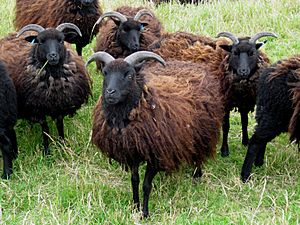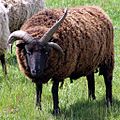Hebridean sheep facts for kids
| Conservation status |
|
|---|---|
| Country of origin | Scotland |
| Traits | |
| Wool color | Black, brown |
| Face color | Black |
| Horn status | Horned |
|
|
The Hebridean is a special type of small, black sheep that comes from Scotland. These sheep are part of a group called Northern European short-tailed sheep, which means they have a short, triangular tail. What makes Hebridean sheep really stand out is that they often have two pairs of horns!
People used to call them "St Kilda" sheep. However, even though other sheep like Soay and Boreray sheep come from the St Kilda archipelago, Hebridean sheep probably do not.
Contents
What Makes Hebridean Sheep Special?
Hebridean sheep have black, somewhat rough wool. This wool can turn brown if it spends a lot of time in the sun, and it often becomes grey as the sheep get older. Their faces and legs do not have any wool. If their wool is not shorn (cut off), it might naturally fall out in the spring, which is called moulting.
How Many Horns Do They Have?
Both male sheep (rams) and female sheep (ewes) usually have one pair of horns. But it's very common for them to have two or even more pairs! This is called being polycerate. Sometimes, a Hebridean sheep might not have any horns at all.
Hebridean Sheep Size and Strength
These sheep are much smaller than most other types of sheep. A fully grown ewe weighs only about 40 kg (88 lb). Rams are a bit heavier, weighing around 50 to 60 kg (110 to 130 lb). Hebridean sheep are very tough and can live well even on rough grazing land.
Hebridean Sheep and Nature Conservation
Because they are so hardy, Hebridean sheep are often used for conservation grazing. This means they help take care of natural grassland or heathland areas. They are especially good at controlling scrub plants because they really like to browse (eat leaves and twigs from bushes).
The History of Hebridean Sheep
Long ago, during the Iron Age, sheep all over Britain were small, had short tails, and came in many different colors. These types of sheep were still around in the 1800s in the Highlands and Islands of Scotland. They were known as the Scottish Dunface sheep. The Dunface had many local types, and most of them are now gone. However, some still exist, like the Shetland and North Ronaldsay sheep.
Where Did They Come From?
The Dunface sheep living in the Hebrides were very small. They had white faces and legs, and their bodies were usually white, but could also be black, brown, reddish-brown, or grey. Their wool was short and soft. Both male and female Dunface sheep usually had horns, and many even had two or three pairs! Over time, the Dunface sheep were slowly replaced by sheep with long tails, like the Scottish Blackface and Cheviot breeds. The Dunface sheep eventually disappeared from the mainland and then from the Hebridean islands too.
Saving the Hebridean Breed
The last known native Hebridean sheep were found on Uist. In the 1880s, some of these sheep were moved from Uist to Storrs Hall in Windermere, Cumbria, in northern England. From there, these sheep were given to different large estates in England and Scotland, often as ornamental animals (pets kept for their beauty). People usually called them "St Kilda" sheep. Eventually, only black sheep remained in these groups.
The black color gene in Hebridean sheep is not found in most European sheep. It is found in some sheep from the Middle East. Scientists think that Hebridean sheep (and also Black Welsh Mountain sheep) got this black gene by breeding with Jacob sheep at some point. Jacob sheep are thought to have come from the Middle East or Mediterranean area and were also often kept as ornamental animals.
In 1973, the Rare Breeds Survival Trust realized that the ornamental Hebridean sheep needed help to survive. Since then, the breed has been brought back, and it is no longer considered rare. Hebridean sheep are now kept in many parts of the world, including their original home in the Hebrides.
Images for kids




